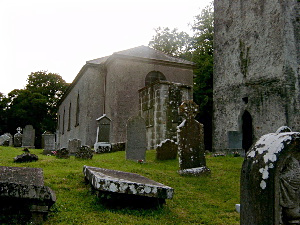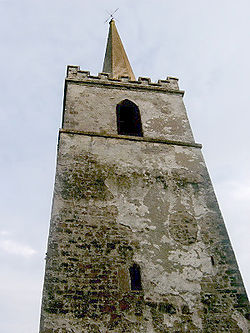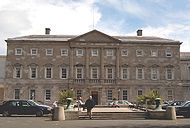
Ardbraccan
Encyclopedia
Ardbraccan is an ancient place of Christian
worship in County Meath
, Ireland
. It is the location of the former residence of the Roman Catholic, then, after the Reformation
, the Church of Ireland
Bishop of Meath
. It is located approximately 30 miles (48 kilometres) from Dublin.

comes directly from the saint's name: Ard Breacain, namely the height or Hill of Braccan. On this high point, a monastery and a succession of churches were built, each larger than the last to accommodate the growing number of religious worshippers. The most famous was a large circular church known as the Daimhliag ("stone house"), which was burned to the ground by Viking
attackers in the 12th century. Contemporary records say that one thousand people were in the church, seeking protection from the invaders, at the time. According to the historical tract Cogad Gaedel re Gallaib, Ardbraccan was the site of a victory of the Uí Néill
over the Vikings sometime in the mid-9th century.
, Lord of Ireland and his forces met with Cathal Crobhderg, King of Connacht and his men in Ardbraccan before proceeding north to attack the forces of Hugh de Lacy, Earl of Ulster.
. Its central importance was shown in the fact that the new merged diocese's bishop lived in Ardbraccan.
 When, in the aftermath of the crisis over Henry VIII
When, in the aftermath of the crisis over Henry VIII
's marriage to Catherine of Aragon
, the Irish Church was ordered to formally break its link with the Roman Catholic Church
to become the Church of Ireland
, the Anglican or Church of Ireland Bishop of Meath continued to live in Ardbraccan in an estate attached to the main church. In this period, Ardbraccan possessed two churches; St. Mary's (which was located in the Bishop's residence) and St. Ultan's, which was named after a local saint who had lived in St. Braccan's day.
church was erected on the site of the earlier church of St. Ultan's. The church remained in use until 1981 when it was deconsecrated, due to the dwindling size of the Church of Ireland community in Ardbraccan, though it ceased to be used for general worship in 1970. The Ecclesisatical Commission of 1868 recorded that there were 267 members of the Church of Ireland living in Ardbraccan parish. By 1968, that had dwindled to 10. The church was finally offered for sale by the Church of Ireland in 2002. Its cemetery is used for burials by both the local Church of Ireland and Roman Catholic parishes.
, who renamed in An Tobar (Irish
for "The Well", linking it to an ancient well at Ardbraccan associated with St. Ultan). When the old church underwent some vandalism, its valuable stained glass windows were removed by the Church of Ireland and donated to An Tobar.
While the Church of Ireland community used the name 'Ardbraccan' to refer to its parish, the nearby Roman Catholic parish in the 19th century opted to use a different name, Bohermeen
, from the Irish An Bóthar Mín, meaning the smooth road, referring to a famous stretch of road that two thousand years before had passed through the neighbourhood and went to Tara, the occasional home of the High King of Ireland
or Ard Rí.
was opened in Ardbraccan. Irish charter schools were operated by The Incorporated Society in Dublin for Promoting English Protestant Schools in Ireland. The Charter Schools admitted only Catholics, under the condition that they be educated as Protestants. These schools were intended, in the words of their programme, "to rescue the souls of thousands of poor children from the dangers of Popish superstition and idolatry, and their bodies from the miseries of idleness and beggary." The Ardbraccan school, like the others, focused on training girls for domestic service in the houses of the gentry and aristocracy, while training boys in agriculture and gardening. As with the other schools, the charter school in Ardbraccan failed and eventually closed down.
 Ardbraccan is also famous for its quarries that supplied cut stone for many Irish and British
Ardbraccan is also famous for its quarries that supplied cut stone for many Irish and British
buildings. The most famous building built with Ardbraccan stone is Leinster House
, once the Dublin residence of the Duke of Leinster
, Ireland's premier peer, and now the seat of the Irish parliament, Oireachtas Éireann.
, The Diocese of Meath (2 Vols, 1862 and 1867)
Christianity
Christianity is a monotheistic religion based on the life and teachings of Jesus as presented in canonical gospels and other New Testament writings...
worship in County Meath
County Meath
County Meath is a county in Ireland. It is part of the Mid-East Region and is also located in the province of Leinster. It is named after the ancient Kingdom of Mide . Meath County Council is the local authority for the county...
, Ireland
Republic of Ireland
Ireland , described as the Republic of Ireland , is a sovereign state in Europe occupying approximately five-sixths of the island of the same name. Its capital is Dublin. Ireland, which had a population of 4.58 million in 2011, is a constitutional republic governed as a parliamentary democracy,...
. It is the location of the former residence of the Roman Catholic, then, after the Reformation
Reformation in Ireland
The Reformation in Ireland was a movement for the reform of religious life and institutions that was introduced into Ireland by the English administration at the behest of King Henry VIII of England. His desire for an annulment of his marriage was known as the King's Great Matter...
, the Church of Ireland
Church of Ireland
The Church of Ireland is an autonomous province of the Anglican Communion. The church operates in all parts of Ireland and is the second largest religious body on the island after the Roman Catholic Church...
Bishop of Meath
Bishop of Meath
The Bishop of Meath is an episcopal title which takes its name after the ancient Kingdom of Meath. In the Roman Catholic Church it remains as a separate title, but in the Church of Ireland it has been united with another bishopric.-History:...
. It is located approximately 30 miles (48 kilometres) from Dublin.

Origins
Ardbraccan originated as a place of Christian worship under St. Breacain (also spelt St. Braccan - d.650 AD ) in the 7th century. Its name in the Irish languageIrish language
Irish , also known as Irish Gaelic, is a Goidelic language of the Indo-European language family, originating in Ireland and historically spoken by the Irish people. Irish is now spoken as a first language by a minority of Irish people, as well as being a second language of a larger proportion of...
comes directly from the saint's name: Ard Breacain, namely the height or Hill of Braccan. On this high point, a monastery and a succession of churches were built, each larger than the last to accommodate the growing number of religious worshippers. The most famous was a large circular church known as the Daimhliag ("stone house"), which was burned to the ground by Viking
Viking
The term Viking is customarily used to refer to the Norse explorers, warriors, merchants, and pirates who raided, traded, explored and settled in wide areas of Europe, Asia and the North Atlantic islands from the late 8th to the mid-11th century.These Norsemen used their famed longships to...
attackers in the 12th century. Contemporary records say that one thousand people were in the church, seeking protection from the invaders, at the time. According to the historical tract Cogad Gaedel re Gallaib, Ardbraccan was the site of a victory of the Uí Néill
Uí Néill
The Uí Néill are Irish and Scottish dynasties who claim descent from Niall Noigiallach , an historical King of Tara who died about 405....
over the Vikings sometime in the mid-9th century.
King John in Ardbraccan
On 29 June 1210 King John of EnglandJohn of England
John , also known as John Lackland , was King of England from 6 April 1199 until his death...
, Lord of Ireland and his forces met with Cathal Crobhderg, King of Connacht and his men in Ardbraccan before proceeding north to attack the forces of Hugh de Lacy, Earl of Ulster.
The Diocese of Ardbraccan
The early Irish church possessed many bishoprics or dioceses, each presided over by a Bishop. For a period, Ardbraccan itself was a diocese, with a large urban centre attached. Under the Synod of Kells in 1152, Ardbraccan was united with the Sees of Clonard, Trim, Dunshaughlin, Slane and Fore, forming with other small dioceses the Diocese of MeathDiocese of Meath
The Diocese of Meath is an Irish diocese which took its name after the ancient Kingdom of Meath. In the Roman Catholic Church it still exists as a separate diocese, but in the Church of Ireland it has been united with other dioceses.-History:...
. Its central importance was shown in the fact that the new merged diocese's bishop lived in Ardbraccan.
From Catholic to Protestant

Henry VIII of England
Henry VIII was King of England from 21 April 1509 until his death. He was Lord, and later King, of Ireland, as well as continuing the nominal claim by the English monarchs to the Kingdom of France...
's marriage to Catherine of Aragon
Catherine of Aragon
Catherine of Aragon , also known as Katherine or Katharine, was Queen consort of England as the first wife of King Henry VIII of England and Princess of Wales as the wife to Arthur, Prince of Wales...
, the Irish Church was ordered to formally break its link with the Roman Catholic Church
Roman Catholic Church
The Catholic Church, also known as the Roman Catholic Church, is the world's largest Christian church, with over a billion members. Led by the Pope, it defines its mission as spreading the gospel of Jesus Christ, administering the sacraments and exercising charity...
to become the Church of Ireland
Church of Ireland
The Church of Ireland is an autonomous province of the Anglican Communion. The church operates in all parts of Ireland and is the second largest religious body on the island after the Roman Catholic Church...
, the Anglican or Church of Ireland Bishop of Meath continued to live in Ardbraccan in an estate attached to the main church. In this period, Ardbraccan possessed two churches; St. Mary's (which was located in the Bishop's residence) and St. Ultan's, which was named after a local saint who had lived in St. Braccan's day.
New church
In 1777 a new Church of IrelandChurch of Ireland
The Church of Ireland is an autonomous province of the Anglican Communion. The church operates in all parts of Ireland and is the second largest religious body on the island after the Roman Catholic Church...
church was erected on the site of the earlier church of St. Ultan's. The church remained in use until 1981 when it was deconsecrated, due to the dwindling size of the Church of Ireland community in Ardbraccan, though it ceased to be used for general worship in 1970. The Ecclesisatical Commission of 1868 recorded that there were 267 members of the Church of Ireland living in Ardbraccan parish. By 1968, that had dwindled to 10. The church was finally offered for sale by the Church of Ireland in 2002. Its cemetery is used for burials by both the local Church of Ireland and Roman Catholic parishes.
Bishop's residence for one thousand years
The Church of Ireland Bishop of Meath moved out of the 18th century bishop's palace in 1885 to live in a smaller mansion nearby, Bishopscourt. In 1958, the Church of Ireland bishop moved away from Ardbraccan altogether, with Bishopscourt being bought by a Catholic religious order, the Holy Ghost FathersHoly Ghost Fathers
The Congregation of the Holy Spirit is a Roman Catholic congregation of priests, lay brothers, and since Vatican II, lay associates...
, who renamed in An Tobar (Irish
Irish language
Irish , also known as Irish Gaelic, is a Goidelic language of the Indo-European language family, originating in Ireland and historically spoken by the Irish people. Irish is now spoken as a first language by a minority of Irish people, as well as being a second language of a larger proportion of...
for "The Well", linking it to an ancient well at Ardbraccan associated with St. Ultan). When the old church underwent some vandalism, its valuable stained glass windows were removed by the Church of Ireland and donated to An Tobar.
While the Church of Ireland community used the name 'Ardbraccan' to refer to its parish, the nearby Roman Catholic parish in the 19th century opted to use a different name, Bohermeen
Bohermeen
Bohermeen is a Roman Catholic parish in the Irish Diocese of Meath. Its English name is a corruption of an ancient Irish language name, An Bóthar Mín, which meant the smooth road. Originally one of the five famed ancient roadways that led from the mediæval capital of Ireland, Tara, approximately 10...
, from the Irish An Bóthar Mín, meaning the smooth road, referring to a famous stretch of road that two thousand years before had passed through the neighbourhood and went to Tara, the occasional home of the High King of Ireland
High King of Ireland
The High Kings of Ireland were sometimes historical and sometimes legendary figures who had, or who are claimed to have had, lordship over the whole of Ireland. Medieval and early modern Irish literature portrays an almost unbroken sequence of High Kings, ruling from Tara over a hierarchy of...
or Ard Rí.
Schools
In 1747 the first Irish Charter SchoolIrish Charter Schools
Irish Charter Schools were operated by The Incorporated Society in Dublin for Promoting English Protestant Schools in Ireland. The Charter Schools admitted only Catholics, under the condition that they be educated as Protestants...
was opened in Ardbraccan. Irish charter schools were operated by The Incorporated Society in Dublin for Promoting English Protestant Schools in Ireland. The Charter Schools admitted only Catholics, under the condition that they be educated as Protestants. These schools were intended, in the words of their programme, "to rescue the souls of thousands of poor children from the dangers of Popish superstition and idolatry, and their bodies from the miseries of idleness and beggary." The Ardbraccan school, like the others, focused on training girls for domestic service in the houses of the gentry and aristocracy, while training boys in agriculture and gardening. As with the other schools, the charter school in Ardbraccan failed and eventually closed down.
Ardbraccan stone

United Kingdom
The United Kingdom of Great Britain and Northern IrelandIn the United Kingdom and Dependencies, other languages have been officially recognised as legitimate autochthonous languages under the European Charter for Regional or Minority Languages...
buildings. The most famous building built with Ardbraccan stone is Leinster House
Leinster House
Leinster House is the name of the building housing the Oireachtas, the national parliament of Ireland.Leinster House was originally the ducal palace of the Dukes of Leinster. Since 1922, it is a complex of buildings, of which the former ducal palace is the core, which house Oireachtas Éireann, its...
, once the Dublin residence of the Duke of Leinster
Duke of Leinster
Duke of Leinster is a title in the Peerage of Ireland and the premier dukedom in that peerage. The title refers to Leinster, but unlike the province the title is pronounced "Lin-ster"...
, Ireland's premier peer, and now the seat of the Irish parliament, Oireachtas Éireann.
Motorway near Ardbraccan
A new motorway will pass near Ardbraccan and the sound of traffic is expected to be audible at the site.Notable persons
- Alexander de BalscotAlexander de BalscotAlexander de Balscot , also known as Alexander Petit was one of the leading Irish clerics of the late fourteenth century, holding the offices of Bishop of Ossory, Bishop of Meath, Treasurer of Ireland and Lord Chancellor of Ireland....
, Bishop of Meath died here 1400. - Edmund OldhallEdmund OldhallEdmund Oldhall was an English-born cleric and judge in fifteenth- century Ireland; he was Bishop of Meath and acting Lord Chancellor of Ireland .He was a brother of the leading Yorkist statesman Sir William Oldhall....
, Bishop of Meath died here 1459. - Richard PocockeRichard PocockeRichard Pococke was an English prelate and anthropologist. He was Protestant Bishop of Ossory and Meath , both dioceses of the Church of Ireland...
, English prelatePrelateA prelate is a high-ranking member of the clergy who is an ordinary or who ranks in precedence with ordinaries. The word derives from the Latin prælatus, the past participle of præferre, which means "carry before", "be set above or over" or "prefer"; hence, a prelate is one set over others.-Related...
and anthropologist - buried here
See also
- Allenstown HouseAllenstown HouseAllenstown House was a large five-bay, four-story Georgian mansion in County Meath, Ireland. It was built in around 1750 by William Waller.The final owner was Vice-Admiral Arthur William Craig who assumed the surname Craig-Waller when he inherited the property in 1920 from a distant relative. In...
- Ardbraccan HouseArdbraccan HouseArdbraccan House is a large Palladian country house in County Meath in the Republic of Ireland...
- Durhamstown CastleDurhamstown CastleDurhamstown Castle is a 500 year old towerhouse in the townland of Durhamstown of the civil parish of Ardbraccan which is in the barony of Lower Navan, in County Meath in Ireland.The precise origins of the building are unknown....
- Saint Ultan of ArdbraccanUltan of ArdbraccanFor the brother of Saint Fursey, see Ultan.St. Ultan of Ardbraccan was an Irish saint and Abbot-Bishop of Ardbraccan during the 7th Century CE....
Additional reading
Dean CoganDean Cogan
Dean Cogan was a nineteenth century Roman Catholic Irish priest, , who wrote a history of the Diocese of Meath in Ireland...
, The Diocese of Meath (2 Vols, 1862 and 1867)

